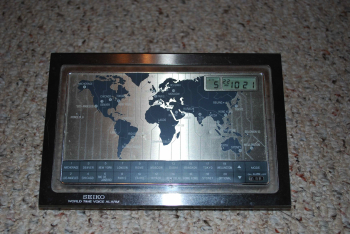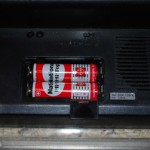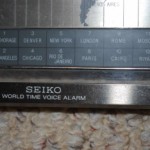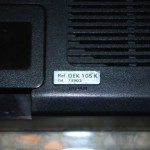I was Bar Mitzvahed on December 3, 1988. That day, I received a slew of gifts, as any young Jewish man becoming a Bar Mitzvah does. One of the gifts I received was a Seiko “World Clock” from the Webber family. I remember using it almost immediately, so either December 4 or December 5 of 1988 is when I gave the clock its first breath of life.
 The clock came with generic batteries. They were a brand called “National Hi-Top.” I can’t say I’d ever heard of them — before or since — however, I used them anyway. This clock became my “main” clock right away. I used it beginning at age 13 for school. Its distinctive alarm chime – “Beep beep beep beep! Beep beep beep beep! Beep beep beep beep! New York: six forty-eight, AM!” would repeat ad nauseum until I dragged myself out of bed to turn it off.
The clock came with generic batteries. They were a brand called “National Hi-Top.” I can’t say I’d ever heard of them — before or since — however, I used them anyway. This clock became my “main” clock right away. I used it beginning at age 13 for school. Its distinctive alarm chime – “Beep beep beep beep! Beep beep beep beep! Beep beep beep beep! New York: six forty-eight, AM!” would repeat ad nauseum until I dragged myself out of bed to turn it off.
Nonetheless, the World Clock worked for me through the remainder of junior high, all of high school, and all of college without flinching. Sometime around the end of college I started to realize that the batteries in the clock had lasted a pretty long time. In fact, the were about to mark a decade of action despite being in use 24 hours a day for 10 straight years and housing an alarm deployed over 200 days a year.
December 4, 1998, I called my parents to let them know that the National Hi-Tops were still kicking.
I noted sometime in December of 2003 that the clock was still plugging away, marking 15 years of action. Pretty impressive for a clock, but much more impressive for generic batteries. If you go to your local CVS, Walgreens, or where ever you buy your batteries, you’ll note that batteries generally have an “expiration date” about 10 years hence. This is because, in time, the liquid inside a battery can dry. The lifespan of a shelved battery is about a decade.
 So imagine my surprise come December 2008, when my little clock celebrated its twentieth year of service. I’m not entirely sure that this is common today in either batteries or electronics, to have a solid build like this. My clock has journeyed from the confines of Simsbury, CT, to Harrisonburg, VA and back many times. It moved with me through Virginia from Vienna to Fairfax to Arlington to Fairlington, then to Florida from to Orlando, Deltona, and Altamonte… twice. This clock has actually been with me, on the same batteries, for more of my life than it hasn’t. Pretty crazy.
So imagine my surprise come December 2008, when my little clock celebrated its twentieth year of service. I’m not entirely sure that this is common today in either batteries or electronics, to have a solid build like this. My clock has journeyed from the confines of Simsbury, CT, to Harrisonburg, VA and back many times. It moved with me through Virginia from Vienna to Fairfax to Arlington to Fairlington, then to Florida from to Orlando, Deltona, and Altamonte… twice. This clock has actually been with me, on the same batteries, for more of my life than it hasn’t. Pretty crazy.
Sometime in the last year or two, I moved on to a different clock for day to day use largely because there is no snooze button on the world clock. However, it still sits here in our house running. When I played with it last week, upon tapping the time zone keys, I noticed the electric, but very British lady’s voice began to warble a little. The ol’ girl has since gotten back on track, but it was the first sign she has ever shown of aging.

 I love my world clock, but mostly I love that she just keeps hanging in there. It’s gone from a hope that the clock survives to a simple interest in seeing how long the batteries will live. It’s impossible to predict how long AA batteries should last, as that fact is governed entirely by the device they are powering and much much power it draws. However, I think it’s safe to conclude that these are fairly extraordinary.
I love my world clock, but mostly I love that she just keeps hanging in there. It’s gone from a hope that the clock survives to a simple interest in seeing how long the batteries will live. It’s impossible to predict how long AA batteries should last, as that fact is governed entirely by the device they are powering and much much power it draws. However, I think it’s safe to conclude that these are fairly extraordinary.

National is/was one of brands (like Panasonic and Technics) of Matsushita (now Panasonic). I was buying their zinc-carbon batteries during the 1988-1991 period. They were better than Toshiba.
Hi-Tops were the BEST dry cells available in South Africa in the 80’s and as a nice bonus they were cheaper than current leading brands.
The current Panasonic batteries SUCK, they are cheap, leaky and have a very very short shelf life.
That was actually a pretty entertaining read. I’m not even sure how I got to it, but, meh… good read. You have a nice writing style, it’s easy to read.
I’m so glad I found your article! My World Clock is now losing time after 20 years and my husband didn’t believe they were the original batteries! I have tried three other types of batteries but they don’t even work in the clock so I am on the prowl for replacements. Guess I’ll email Seiko direct.
Hello, you don't know me. I did a search for National Hi-Top batteries and found your page. I found the same exact batteries in an old remote control for a Kenwood stereo system my dad has owned since the 70's. It's a gigantic remote control, with 6 of these “Sum-3” National Hi-Tops. The batteries still work quite well. I'm going to see if I can find more.
Hello, you don't know me. I did a search for National Hi-Top batteries and found your page. I found the same exact batteries in an old remote control for a Kenwood stereo system my dad has owned since the 70's. It's a gigantic remote control, with 6 of these “Sum-3” National Hi-Tops. The batteries still work quite well. I'm going to see if I can find more.
This may be a bit late, but I wrote the date on my “National Hi-Top” batteries when I replaced them the last time – 8/2/1983 – 28 years ago!! I use them in my calculator, and because I am a financial advisor, it is used every day -amazing!!
I found this page after searching “national hi-top”.
When i was a kid of around 7 years old (early Seventies —40years ago) I had various battery operated radios, flashlights, cars etc.
I also had a collection of random batteries that would be shuffled from one toy to the next….many battery brands and sizes (we never seemed to get new ones, they were always sourced from broken toys).
As the years went on, more and more of these batteries finally died and were thown away but it seemed that you could always rely on the National Hi-Top to be in good shape. They became my ‘favorite’ battery. I think I only had 2 c-cells of hi-tops but I’m sure I used them for years in many different devices. It warms my heart to see the photo above of my old friends the ‘National Hi-Tops’ !
This is a long time later, but I have a similar story. I received a Seiko world clock as a gift from my fiance, before we were married, back in 1991. It had the same Seiko National Hi-Top AA batteries. I’ve used the clock as my office desk clock continuously since then. The batteries finally died last month – 25 years after I received the clock.
I had almost the same experience! I got my World Clock in 1987, and the batteries lasted until 2008. I saved the National Hi-Tops as a memento, and the clock is eight years into its second set of batteries. Let’s see how long Duracell will make it…